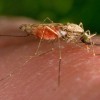 Anopheles gambiae Giles is commonly called the African malaria mosquito because it is the most efficient vector of human malaria in the Afrotropical Region. They are considered to be one of the world’s most important human malaria vectors because of their susceptibility to the Plasmodium parasite, their preference for humans as a host, and their indoor-feeding behavior. Due to their short development time and their preference for developmental habitats near human dwellings, Anopheles gambiae are considered effective vectors of human malaria, as well as lymphatic filariasis (elephantiasis). This 6-page fact sheet was written by Sabrina A. White and Phillip E. Kaufman, and published by the UF Department of Entomology and Nematology, September 2014.
Anopheles gambiae Giles is commonly called the African malaria mosquito because it is the most efficient vector of human malaria in the Afrotropical Region. They are considered to be one of the world’s most important human malaria vectors because of their susceptibility to the Plasmodium parasite, their preference for humans as a host, and their indoor-feeding behavior. Due to their short development time and their preference for developmental habitats near human dwellings, Anopheles gambiae are considered effective vectors of human malaria, as well as lymphatic filariasis (elephantiasis). This 6-page fact sheet was written by Sabrina A. White and Phillip E. Kaufman, and published by the UF Department of Entomology and Nematology, September 2014.
http://edis.ifas.ufl.edu/in1048
Tag: Family: Culicidae (mosquitos)
A Mosquito Culex (Melanoconion) pilosus (Dyar and Knab) (Insecta: Diptera: Culicidae) (EENY521/IN930)
 This small, dark mosquito tends to feed on reptiles and amphibians. It is found in the southeastern United States and many countries in Central America and South America. This 3-page fact sheet was written by Diana Vork and C. Roxanne Connelly, and published by the UF Department of Entomology and Nematology, April 2012.
This small, dark mosquito tends to feed on reptiles and amphibians. It is found in the southeastern United States and many countries in Central America and South America. This 3-page fact sheet was written by Diana Vork and C. Roxanne Connelly, and published by the UF Department of Entomology and Nematology, April 2012.
http://edis.ifas.ufl.edu/in930
El Mosquito Culex Iolambdis (ENY727S/IN901)
Culex (melanoconion) iolambdis es un mosquito pequeño de color marrón oscuro que existe en sitios tropicales y subtropicales. En los Estados Unidos, solo se encuentra en el sur de Florida. Se conoce poco sobre la biología y comportamiento de este mosquito. El subgenéro Melanoconion se distingue por el pequeño tamaño de sus especies y por dificultad en diferenciar las diferentes especies. This 4-page fact sheet was written by Jorge R. Rey, Erik M. Blosser, Stephanie K. Larrick and C. Roxanne Connelly, and published by the UF Department of Entomology and Nematology, September 2011.
http://edis.ifas.ufl.edu/in901
EENY481/IN870 a mosquito Culex (Melanoconion) iolambdis Dyar (Insecta: Diptera: Culicidae)
EENY481, a 5-page illustrated fact sheet by Stephanie K. Larrick, Erik M. Blosser, and C. Roxanne Connelly, is part of the Featured Creatures collection. It describes this small, dark brown mosquito that exists in the tropics and subtropics and about which little is known — distribution, description, biology, medical importance, and management. Includes references. Published by the UF Department of Entomology and Nematology, August 2010.
http://edis.ifas.ufl.edu/in870
EENY457/IN837 Southern House Mosquito Culex quinquefasciatus Say
EENY457, a 6-page illustrated fact sheet by Stephanie Larrick and Roxanne Connelly, is part of the Featured Creatures collection. It describes this medium-sized brown mosquito that exists throughout the tropics and the lower latitudes of temperate regions and is a vector of many pathogens, several of which affect humans — synonymy, distribution, description, life cycle, medical importance, and management. Includes references. Published by the UF Department of Entomology and Nematology, November 2009.
http://edis.ifas.ufl.edu/IN837
EENY434/IN792 Yellow fever mosquito Aedes aegypti (Linnaeus) (Insecta: Diptera: Culicidae)
EENY-434, an 8-page illustrated fact sheet by Catherine Zettel and Phillip Kaufman, is part of the Featured Creatures collection. It describes this container-inhabiting mosquito that is the primary vector of yellow fever — its synonymy, distribution, life cycle, medical importance, and management. Includes selected references. Published by the UF Department of Entomology and Nematology, February 2009.
http://edis.ifas.ufl.edu/IN792
EENY491/IN791 Common malaria Mosquito Anopheles quadrimaculatus Say (Insecta: Diptera: Culicidea)
EENY-491, a 6-page illustrated fact sheet by Leslie M. Rios and C. Roxanne Connelly, describes this historically most important vector of malaria in the eastern United States — synonymy, distribution, description, life cycle, medical significance, surveillance and management. Includes selected references. Published by the UF Department of Entomology and Nematology, February 2009.
http://edis.ifas.ufl.edu/IN791